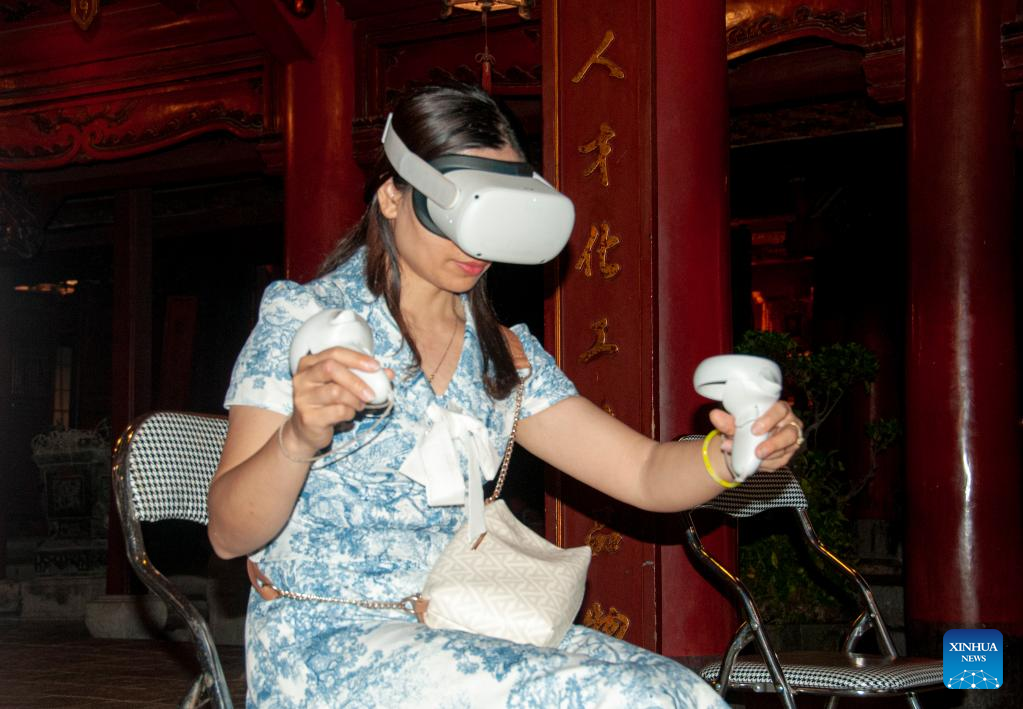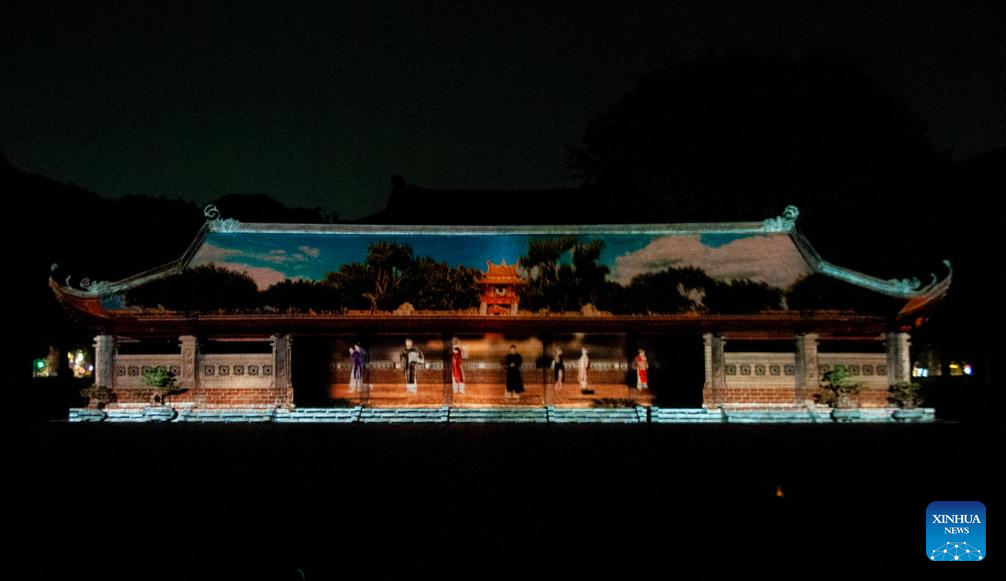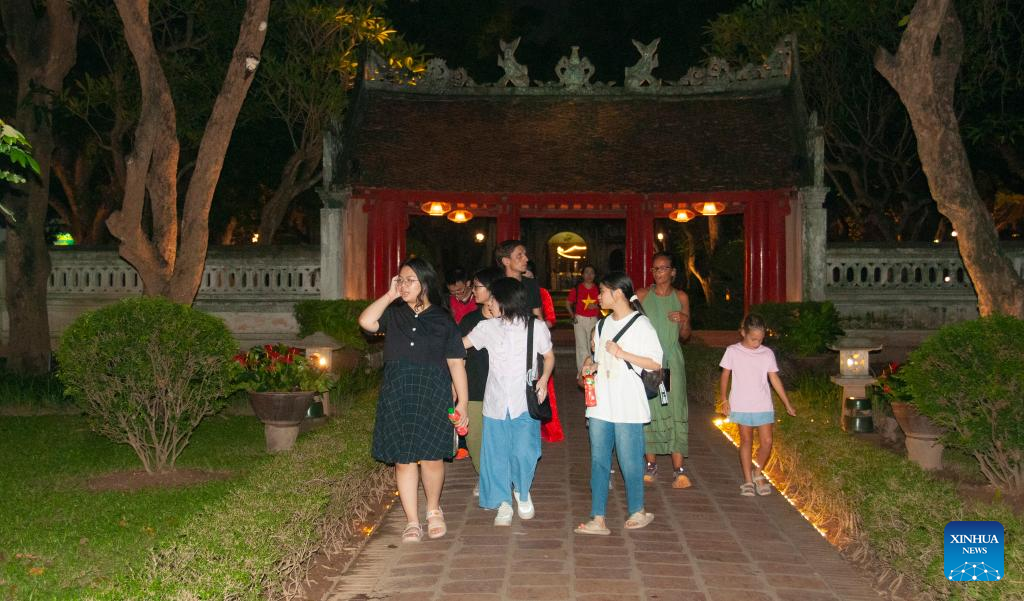
A woman tries an AR/VR application at Temple of Literature in Hanoi, Vietnam, June 4, 2025. In the Vietnamese capital of Hanoi, the Temple of Literature, known locally as Van Mieu, has begun using digital projection technologies to present its cultural heritage in a new light, drawing growing interest from both local and international visitors. Built in 1070 during Vietnam's Ly Dynasty, the site is one of the country's oldest and most revered historical landmarks, originally established to honor Confucius and later serving as Vietnam's first national university, Quoc Tu Giam. (Photo by Dang Hong Dung/Xinhua)
HANOI, June 8 (Xinhua) -- In the Vietnamese capital of Hanoi, the Temple of Literature, known locally as Van Mieu, has begun using digital projection technologies to present its cultural heritage in a new light, drawing growing interest from both local and international visitors.
Built in 1070 during Vietnam's Ly Dynasty, the site is one of the country's oldest and most revered historical landmarks, originally established to honor Confucius and later serving as Vietnam's first national university, Quoc Tu Giam.
The temple, long seen as a symbol of Vietnam's traditional respect for education and scholarship, now features a nighttime experience that uses 3D mapping projections to transform its historic walls into a dynamic visual stage.
Under a program titled "The Quintessence of Education," animated imagery is projected onto the Tien Duong building in the Thai Hoc courtyard, combining light, sound and motion to illustrate traditional symbols, classical examinations, and cultural values rooted in education.
By blending historical content with digital storytelling, the performance aims to make the site's cultural legacy more accessible to younger generations and international visitors unfamiliar with Vietnamese history.
Thu Thuy, a Vietnamese visitor, said she came to the Temple of Literature for the first time after learning about the night tour on social media and was particularly drawn by the use of 3D projection technology.
She said the visuals helped her notice architectural details and historical symbols that she might otherwise have missed, adding that the format made the experience easier to understand.
"It's a good way for people who don't know much about history to connect with it more deeply," she said, noting that she would recommend it to others.
Jim Glovier, a visitor from the United States, said the nighttime experience gave him a different impression compared to his daytime visit to the site in 2018, as the projected visuals helped clarify the narrative and highlight cultural messages.
He described the performance as easy to follow, even for someone unfamiliar with the historical background, and said the storytelling helped him better appreciate the site's educational significance.
According to Duc Phuc, a staff member at the temple's communications office, the 3D mapping projection has been part of the evening tour since 2022 and has played an important role in attracting more visitors to both the temple and Hanoi in general.
He said the use of technology adds a strong visual element that leaves a lasting impression and supports the communication of educational values in a more engaging and modern format.
Phuc added that 3D mapping is just one of several tools the temple has adopted, alongside AR/VR applications, holographic displays, AI-driven interactive systems and video walls aimed at enhancing the visitor experience.
"In today's context, if technology helps preserve and promote culture, we should embrace it as part of our development," he said.
According to the Hanoi Department of Tourism, the city recorded around 12.77 million tourist arrivals in the first five months of 2025, with nearly 70,000 people visiting the Temple of Literature during the Lunar New Year holidays. ■

This photo taken on June 4, 2025 shows a 3D mapping projection on the facet of a building at Temple of Literature in Hanoi, Vietnam. In the Vietnamese capital of Hanoi, the Temple of Literature, known locally as Van Mieu, has begun using digital projection technologies to present its cultural heritage in a new light, drawing growing interest from both local and international visitors.
Built in 1070 during Vietnam's Ly Dynasty, the site is one of the country's oldest and most revered historical landmarks, originally established to honor Confucius and later serving as Vietnam's first national university, Quoc Tu Giam. (Photo by Dang Hong Dung/Xinhua)

Tourists take a night tour at Temple of Literature in Hanoi, Vietnam, June 4, 2025. In the Vietnamese capital of Hanoi, the Temple of Literature, known locally as Van Mieu, has begun using digital projection technologies to present its cultural heritage in a new light, drawing growing interest from both local and international visitors.
Built in 1070 during Vietnam's Ly Dynasty, the site is one of the country's oldest and most revered historical landmarks, originally established to honor Confucius and later serving as Vietnam's first national university, Quoc Tu Giam. (Photo by Dang Hong Dung/Xinhua)
